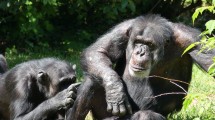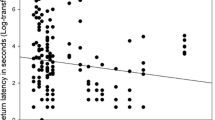Abstract
Many studies have focused on the responses of primates to changes in population density, but little is known about the responses to more subtle changes in the physical environment. Studies on primate responses to high density supported the use of various coping strategies depending on the circumstances. We investigated which strategy was adopted by a large group of captive chimpanzees in response to a special case of space restriction: the temporary reduction of escape opportunities. Due to work on the outdoor enclosure, the chimpanzees at Chester Zoological Gardens were confined to their indoor quarters for 1 mo. As it was winter, the chimpanzees spent most of their time indoors also during the 7-week control period, but had the option to go outside. Therefore, there was no major difference in the actual density between the two conditions, but by being confined indoors the chimpanzees had reduced escape opportunities. Under this condition they would be expected not to alter their behavior dramatically but to adjust it in ways to avoid conflict and to reduce tension. The chimpanzees did not change their overall aggression rates during the period with a reduction of escape opportunities versus the control period. The patterns of allogrooming and submissive greetings also did not differ between the two periods. However, they appeared to refrain from joining ongoing aggressive interactions during the period with reduced escape opportunities, whereas no change in counteraggression occurred between the two periods. Our findings suggest that the chimpanzees may adopt a selective inhibition strategy when escape opportunities are limited. Further support for such selectivity comes from the analysis of different types of aggressor-target dyads. During the period with reduced escape opportunities, aggression rates decreased in dyads characterized by high aggression rates at baseline, i.e., high aggressor-target dyads, whereas the same individuals did not change their aggressive tendencies in low aggressor-target dyads. Ours is among the few studies showing a decrease, albeit selective, in aggressive behavior during a situation of space restriction. The ability to rapidly adopt an appropriate strategy and to inhibit aggression during such restriction seems to confirm findings of chimpanzees under high density conditions. The inhibition of aggressive tendency may be especially developed in chimpanzees and may be related to the natural challenges posed by the routine changes in subgroup membership characteristic of their fission-fusion social organization.
Similar content being viewed by others
References
Altmann, J. (1974). Observational study of behavior: Sampling methods. Behaviour 49: 227-266.
Angst, W. (1980). Aggression bei Affen und Menschen, Springer, Berlin.
Aureli, F., and de Waal, F. B. M. (1997). Inhibition of social behaviour in chimpanzees under high-density conditions. Am. J. Primatol. 41: 213-228.
Aureli, F., and de Waal, F. B. M. (2000). Natural Conflict Resolution, University of California Press, Berkeley, CA.
Aureli, F., Seres, M., Whitten, P. L., and de Waal, F. B. M. (2001). Living conditions affect stress levels of captive chimpanzees. Am. J. Primatol. 54: 67-68.
Aureli, F., van Panthaleon, C. J., van Eck, C. J., and Veenema, H. C. (1995). Long-tailed macaques avoid conflicts during short-term crowding. Aggr. Behav. 21: 113-122.
Baker, K. C., and Aureli, F. (1996). The neighbor effect: Other groups influence intragroup agonistic behavior in captive chimpanzees. Am. J. Primatol. 40: 283-291.
Boesch, C., and Boesch-Acherman, H. (2000). The Chimpanzees of the Taï Forest—Behavioural Ecology and Evolution, Oxford University Press, Oxford.
Calhoun, J. B. (1962). Population density and social pathology. Sci. Am. 206: 139-148.
de Waal, F. B. M. (1987). Tension regulation and nonreproductive functions of sex in captive bonobos (Pan paniscus). Natl. Geogr. Res. 3: 318-335.
de Waal, F. B. M. (1989). The myth of a simple relationship between space and aggression in captive primates. Zoo Biol. Suppl. 1: 141-148.
de Waal, F. B. M. (1992). Appeasement, celebration, and food sharing in the two Pan species. In Nishida, T., McGrew, W. C., Marler, P. R., Pickford, M., and de Waal, F. B. M. (Eds.), Topics in Primatology, University of Tokyo Press, Tokyo, pp. 37-50.
de Waal, F. B. M. (1997). The chimpanzee's service economy: Food for grooming. Evol. Hum. Behav. 18: 375-386.
de Waal, F. B. M., Aureli, F., and Judge, P. G. (2000). Coping with crowding. Sci. Am. 282(5): 54-59.
Erwin, J. (1979). Aggression in captive macaques: Interaction of social and spatial factors. In Erwin, J., Maple, T., and Mitchell, G. (Eds.), Captivity and Behavior, Van Nostrand Rheinhold, New York, pp. 139-171.
Erwin, J., Anderson, B., Erwin, N., Lewis, L., and Flynn, D. (1976). Aggression in captive pigtail monkey groups: Effects of provision of cover. Percept Mot. Skills 42: 319-324.
Estep, D. Q., and Baker, S. C. (1991). The effects of temporary cover on the behavior of socially housed stumptailed macaques (Macaca arctoides). Zoo Biol. 10: 465-472.
Goodall, J. (1986). The Chimpanzees of Gombe: Patterns of Behavior. Harvard University Press, Cambridge, MA.
Judge, P. G. (2000). Coping with crowded conditions. In Aureli, F., and de Waal, F. B. M. (Eds.), Natural Conflict Resolution, University of California Press, Berkeley, CA, pp. 129-154.
Judge, P. G., and de Waal, F. B. M. (1993). Conflict avoidance among rhesus monkeys: Coping with short-term crowding. Anim. Behav. 46: 221-232.
Judge, P. G., and de Waal, F. B. M. (1997). Rhesus monkey behaviour under diverse population densities: Coping with long-term crowding. Anim. Behav. 54: 643-662.
Koyama, N. F. (2000). Conflict prevention before feeding. In Aureli, F., and de Waal, F. B. M. (Eds.), Natural Conflict Resolution, University of California Press, Berkeley, CA, pp. 130-132.
Koyama, N. F., and Dunbar, R. I. M. (1996). Anticipation of conflict by chimpanzees. Primates 37: 79-86.
Manly, B. F. J. (1997). Randomization, Bootstrap and Monte Carlo Methods in Biology, Chapman & Hall, London.
Mayagoitia, L., Santillan-Doherty, A. M., Lopez-Vergara, L., and Mondragon-Ceballos, R. (1993). Affiliation tactics prior to a period of competition in captive groups of stumptail macaques. Ethol. Ecol. Evol. 5: 435-446.
Morris, D. (1969). The Human Zoo, McGraw-Hill, New York.
Nash, L. T., and Chilton, S. (1986). Space or novelty?: Effects of altered cage size on Galago behavior. Am. J. Primatol. 10: 37-49.
Nieuwenhuijsen, K., and de Waal, F. B. M. (1982). Effects of spatial crowding on social behavior in a chimpanzee colony. Zoo Biol. 1: 5-28.
Nishida, T. (1979). The social structure of chimpanzees of the Mahale Mountains. In Hamburg, D. A., and McCown, E. R. (Eds.), The Great Apes, The Benjamin/Cummings, Menlo Park, CA, pp. 73-121.
Novak, M. A., O'Neill, P., and Suomi, S. J. (1992). Adjustments and adaptations to indoor and outdoor environments: Continuity and change in young adult rhesus monkeys. Am. J. Primatol. 28: 125-139.
Rom, D. M. 1990. A sequencially rejective test procedure based on a modified Bonferroni inequality. Biometrika 77: 663-665.
Russell, C., and Russell, W. M. S. (1968). Violence, Monkeys and Man, Macmillian, London.
Smuts, B. B., Cheney, D. L., Seyfarth, R. M., Wrangham, R. W., and Struhsaker, T. T. (1987). Primate Societies, The University of Chicago Press, Chicago.
Southwick, C. H. (1967). An experimental study of intragroup agonistic behavior in rhesus monkeys (Macaca mulatta). Behaviour 28: 182-209.
van Hooff, J. A. R. A. M. (1974). A structural analysis of the social behavior of a semi-captive group of chimpanzees. In von Cranach, M., and Vine, I. (Eds.), Social Communication and Movement, Academic Press, London, pp. 75-162.
Wilson, C. C. (1972). Spatial factors and the behavior of nonhuman primates. Folia Primatol. 18: 256-275.
Author information
Authors and Affiliations
Corresponding author
Rights and permissions
About this article
Cite this article
Caws, C., Aureli, F. Chimpanzees Cope with Temporary Reduction of Escape Opportunities. International Journal of Primatology 24, 1077–1091 (2003). https://doi.org/10.1023/A:1026280329544
Issue Date:
DOI: https://doi.org/10.1023/A:1026280329544




